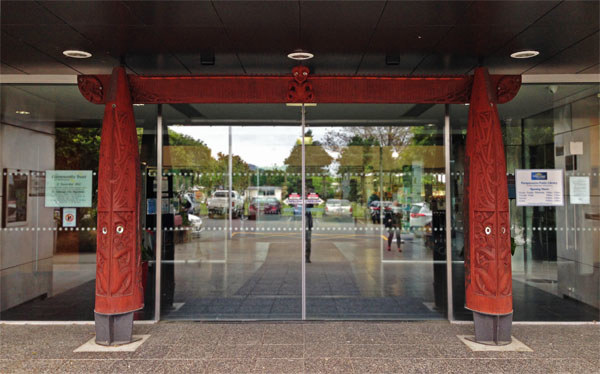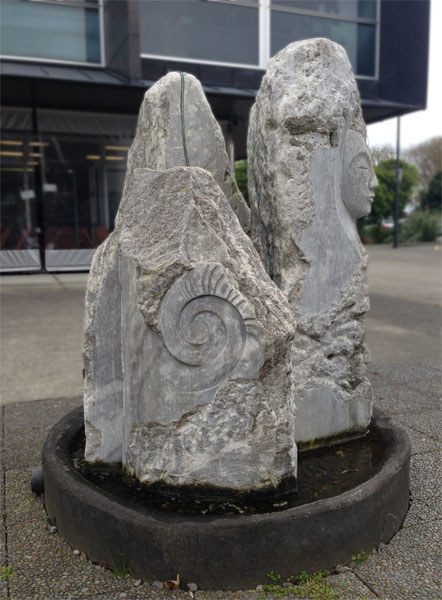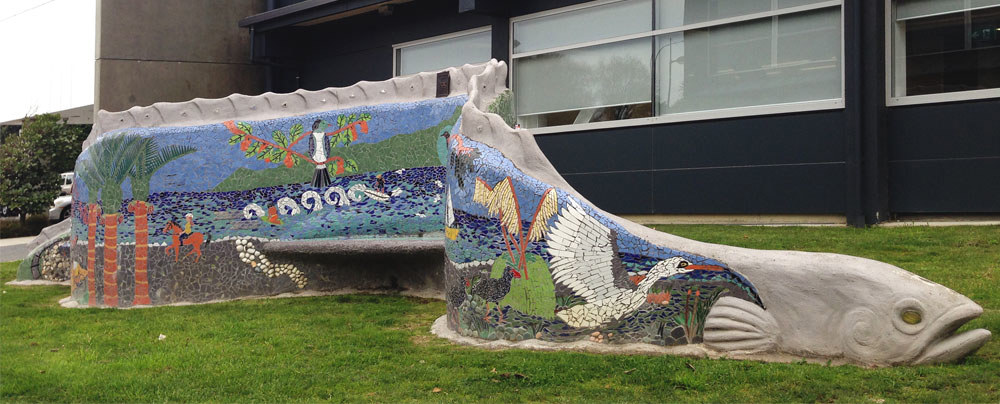Art in the libraries
The libraries are home to community art exhibition spaces and significant art works by local artists, including Hemi Sundgren, Ra Vincent, John Bevan Ford, Alan Wehipeihana and Shona Moller.
Paraparaumu and Ōtaki libraries have community artspaces, giving members of the public and local groups the opportunity to show their work, and our community the opportunity to view the work of lesser known local artists.
For information about the Kāpiti Arts Trail, please visit our Kāpiti Coast Art Trail.
Library Artworks:
- Te Hekenga -The Migration - Hemi Sundgren
- Kaitiaki - Ra Vincent
- Te Tuna ki Paraparaumu - Debra Bustin
- Wharetangata - Alan Wehipeihana
- He Tangata - Noel Osborne
- Kupe Coastlines - John Bevan Ford
- Tararua Tapestry - Alan Wehipeihana
Māori Art in the Libraries
While there are three iwi recognised as tangata whenua in the Kāpiti Coast District Council area, Te Āti Awa ki Whakarongotai is the principal iwi of the Paraparaumu area. When the new Paraparaumu Library was being planned it was decided by iwi that there would be two specifically local Māori projects - a kuaha (entranceway carving) to be designed by, and carved in wood by Hemi Sundgren and a stone water feature (situated at the eastern end between the Council and library buildings), to be designed and carved by Ra Vincent. Both artists are from Te Āti Awa ki Whakarongotai, are highly regarded by the iwi and have established reputations as Kāpiti artists. Ra's great grandmother owned the land on which the library is built.
Library Artworks
Te Hekenga - The Migration - Paraparaumu Library

Artist: Hemi Sundgren (Te Āti Awa ki Whakarongotai)
Designer: Hemi Sundgren.Te Hekenga was carved by Hemi with the assistance of Shannon Wafer (Te Āti Awa) and Tamati Holmes (Te Āti Awa). Wood and copper.
Te Hekenga provides the entranceway to Te Whare Whakamatau o Paraparaumu (Paraparaumu Library). The three waka symbolise the three iwi of the Kāpiti Coast - Te Āti Awa ki Whakarongotai, Ngāti Raukawa ki te Tonga me Ngā Hapū o Ōtaki, Ngāti Toa Rangatira - and their migration to the Kāpiti Coast.
The hull on the left represents the iwi Ngāti Raukawa ki te Tonga, while the hull on the right represents Ngāti Toa Rangatira and their respective rangatira who had particular interests in land settled by Te Āti Awa ki Whakarongotai. The Pare or cross beam is also a waka that represents the mana whenua of the Paraparaumu-Waikanae area, namely all the hapū of Te Āti Awa ki Whakarongotai. The waka may also be seen as a symbol of the human person journeying through life to achieve specific goals. This is likened to all peoples, all cultures and all ages entering the library who must navigate their waka in the right direction to achieve their purpose. “The waka represents life and it teaches life.” (Pakake Winiata)
Fundraising was by the Friends of the Library, in conjunction with The Community Trust of Wellington
Kaitiaki - Paraparaumu Library

Artist: Ra Vincent
The Takaka marble used for this water feature came from the now refurbished government buildings in Wellington. The marble stones have been largely left in their original form but have been carved with images appropriate to the Kāpiti area:
•Harakeke - a prominent plant in the area representing whanau; two adult leaves giving protection to new growth.
•Puwerewere - a traditional symbol of the spider and in this piece depicts the pukeko's footprints and the path of nature.
•The face of people as guardians of this land.
The stones are united by flowing water to symbolise the harmony we can achieve between ourselves and the beautiful coastline we share.
Te Tuna Ki Paraparaumu - Paraparaumu Library

Artists: Designed by Debra Bustin, concrete shape made by Joe T Richardson, mosaic pattern designed and applied by Gail Lewis with assistance from a wide variety of helpers.
The inspiration for the seat comes from Spanish Architect Antoni Gaudi, famous for designing multi- dimensional forms with flowing curves and shapes often covered with mosaic tiles. The surface of Te Tuna ki Paraparaumu is covered with pictures and symbols representative of the Kāpiti Coast - pukeko, nikau palms, Kāpiti Island etc. Te Tuna faces the nearest awa - the Wharemauku Stream,
Money for this project was received from the Lotteries Commission and the Lion Foundation.
Wharetangata – The house of the people - Ōtaki Library

Artist: Alan Wehipeihana (Ngāti Raukawa)
Limestone.
The stone is a womb with a child inside. This type of limestone is said to be about 65 million years old. It is a relatively young stone but still incredibly ancient in human terms. Over time, as life passes from one manifestation to the next, there are times when minerals and material that will one day be incorporated into living cells, dwell in stone. Stone is one of those places from which we have sprung.
Alan Wehipeihana is of Ngati Raukawa descent on his father’s side and English on his mother’s. The use of images, icons and beliefs from both cultures is evident in his work. He uses Maori motifs such as the pitau, koru and waka. Icons and imagery associated with his English heritage include halos, saints and imagery of the Garden of Eden. Although he started as a painter in 1999, Alan is better known for his stone and woodcarvings. He has been exhibiting his work consistently since 1994 through selected galleries around the country. Based in Paekakariki, Alan has been a full time artist for over 10 years.
Purchased by Kāpiti Coast Community Arts Council, around 1998 – 2000 and on long-term loan to the Kāpiti Coast District Libraries.
Carver: Noel Osborne
Montane Totara Podocarpus Cunninghamii.
He Tangata reflects all people in the rohe (district), represented by three stages of life: Tamarikitanga - Childhood; Pakeketanga - Adulthood; and Kaumātuatanga - The senior years. The reflection reminds us of the value of everyone at various stages of their lives and how they impact on each other during Te Mataora (The life cycle).
He Tangata was unveiled on October 3rd 2008 by Councillor Hilary Wooding and blessed by Kaumātua Ake Taiaki.
Proudly sponsored by Kāpiti Friends of the Library, Lion Foundation, Pub Charity & the NZ Community Trust.
Kupe Coastlines (2001) - Paraparaumu Library
Artist: John Bevan Ford (Ngāti Raukawa).
Mixed Media.
Drawing on Charles Heaphy's coastal profiles, John Bevan Ford uses a three tier structure to combine representations of the Kāpiti Coast area (lower section), Wellington Harbour (middle section), and the wider Pacific (top section). The Kāpiti Coast section alludes to the arrival of both Māori and Pakeha. Kupe and his daughters are depicted, as are the ships of Abel Tasman and James Cook.
Donated by David & Stuart Pritchard, Mike Welch and Grant Paterson.
Tararua Tapestry - Paraparaumu Library
Artist: Alan Weihipeihana (Ngāti Raukawa)
Oil on canvas.
Alan's work depicts the six mountains of the Kāpiti district: Pukemoumou, Tararua, Kāpiti, Kapakapanui, Wainui and Tuteremoana.
